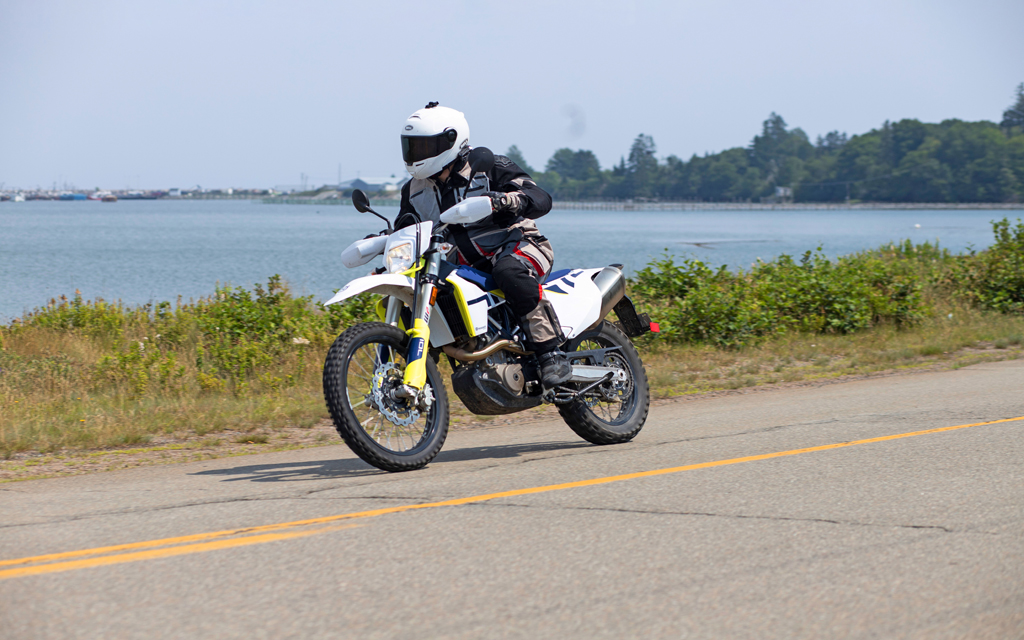*This article was published in Vol. 51 No. 7 of Cycle Canada digital magazine.
SINGLE AND LOVING IT
It’s the brappiest dual sport you can buy
The secret to understanding the updated-for-2021 Husqvarna 701 Enduro is all in the name. As in, 701. This is a massive single-cylinder engine.
And as in, Enduro. Although this is a street legal motorcycle, you don’t get the standard cushy streetbike experience. Instead, you get rip-your-face-off acceleration, and handling that keeps you on your toes.
The engine is the same muscular 693 cc four-stroke single that KTM started developing way back in 1987. Back then, it was a kickstart-only dirtbike powerplant, growing in size and refinement over the years, until it hit its current 693 cc capacity in 2016, powering KTM’s 690 Duke R. Today’s version, with a claimed 74 horsepower at 8,000 rpm and 54.2 pound-feet of torque at 6,500 rpm, is the most powerful production single-cylinder engine ever made.
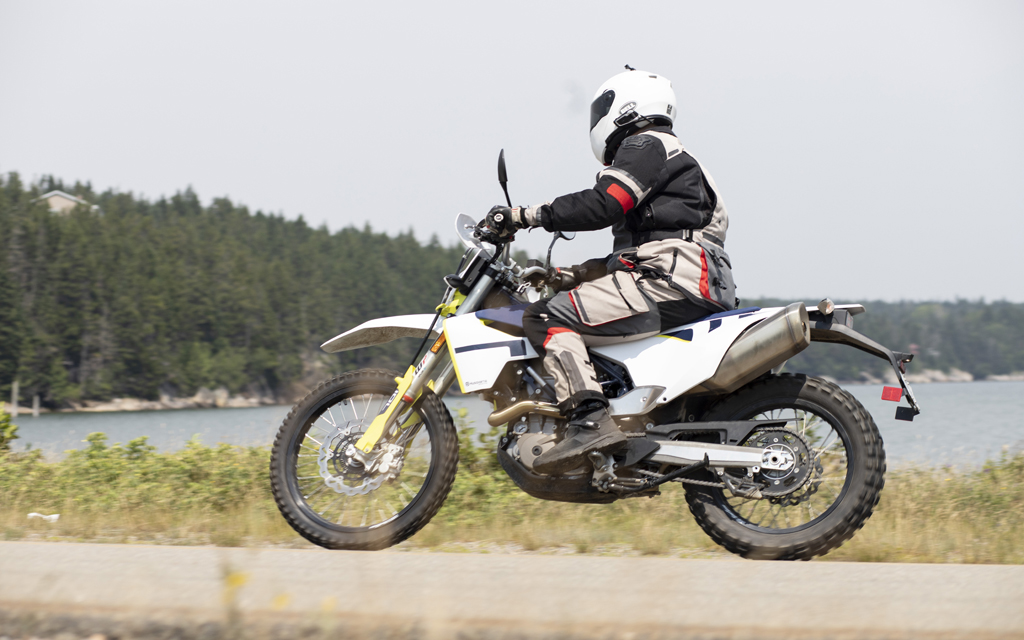
Since KTM and Husky are now joined at the hip, the Husqvarna 701 now gets the same super-powerful single.
If you think that engine sounds like fun, you’re right. Here’s what I jotted down in my notebook after a few minutes on the 701, heading down a farm road in the New Brunswick countryside: “Within minutes, I am changed into a giggling mess, cackling like a mad scientist who’s just discovered a weapon of immense power. The result of the torque is an intoxicating rush, at least for me.”
The secret to the 701’s greatness is not just horsepower and torque numbers. Although it has decent output, the 701 still lags far behind a modern middle-weight multi-cylinder bike.
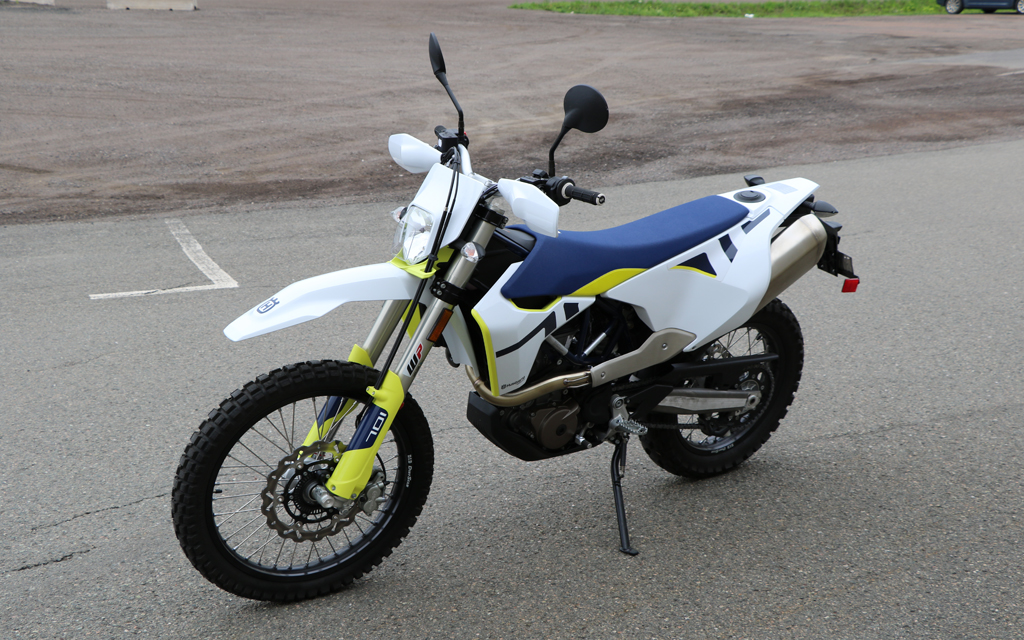
The 701 has upsides of a single (lots of torque, a linear power curve, lots of engine braking), but none of the downsides. The 701 revs quickly, and thanks to careful design (two counterbalancer shafts), the vibrations don’t become terribly unpleasant. You can spin the guts out of it, in situations where Japanese 650s would run out of steam. High-rpm roll-on power in sixth gear is impressive, but there’s still enough low-down torque for crazy wheelie fun, if you want to grab a mittfull of throttle (and maybe some clutch, in higher gears).
As a result, the 701 encourages hoonish behaviour. On tight back roads, it exits corners with rocketship speed (Jeff Bezos could have saved a lot of money by buying a 701 instead of paying for a space flight). Around town, if the kids bumming around the car wash ask you to do a wheelie, it’s no problemo (hypothetically speaking, of course). On the highway, if you’re going 120 km/h and you want to pass a cager on an uphill while battling a headwind, just crack that throttle and you’re gone. Good luck doing that on your clapped-out Gen 1 KLR650.
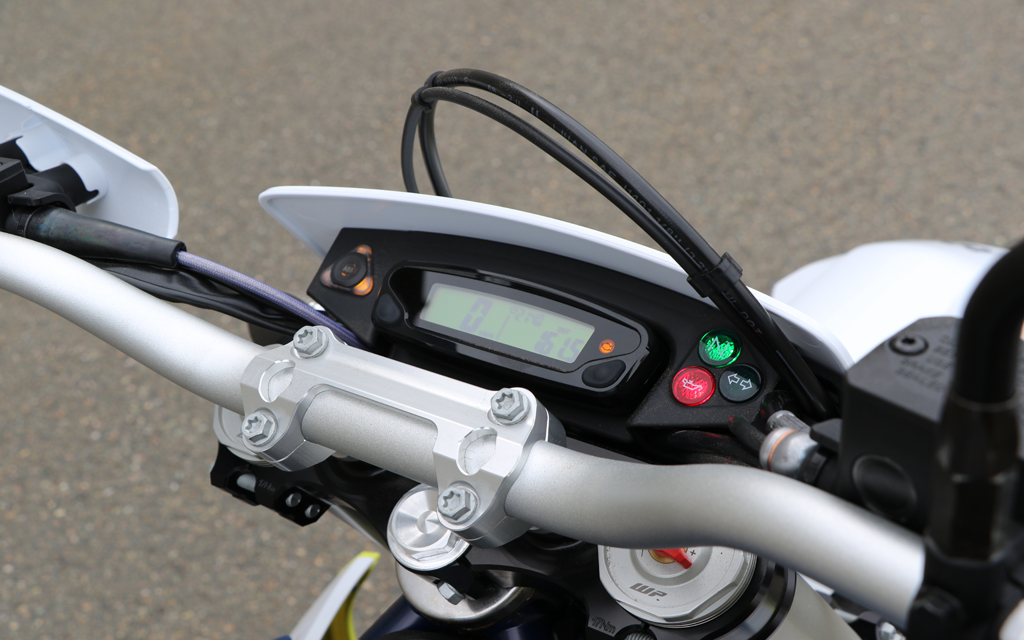
All fine and dandy on the street, then. What about offroad?
This is where things get a bit more tricky. The 701 has a lot of power, and power isn’t always your friend when you’re riding in the dirt. If you’re in loose sand or gravel, the 701 is lots of fun. The lean angle-sensitive traction control system keeps everything in line on roads, and you can always turn it off if you want to goose the bike through corners slideways.
However, when the trail gets narrow and bumpy, the power is less useful. If you’re running around a tight track with the throttle wide open, that 70+ horsepower might punt you off into the woods, or wrap you around a tree. I have no doubt that hairy-chested enduro pros are riding these things around on single-track, but I’m not anxious to do so.
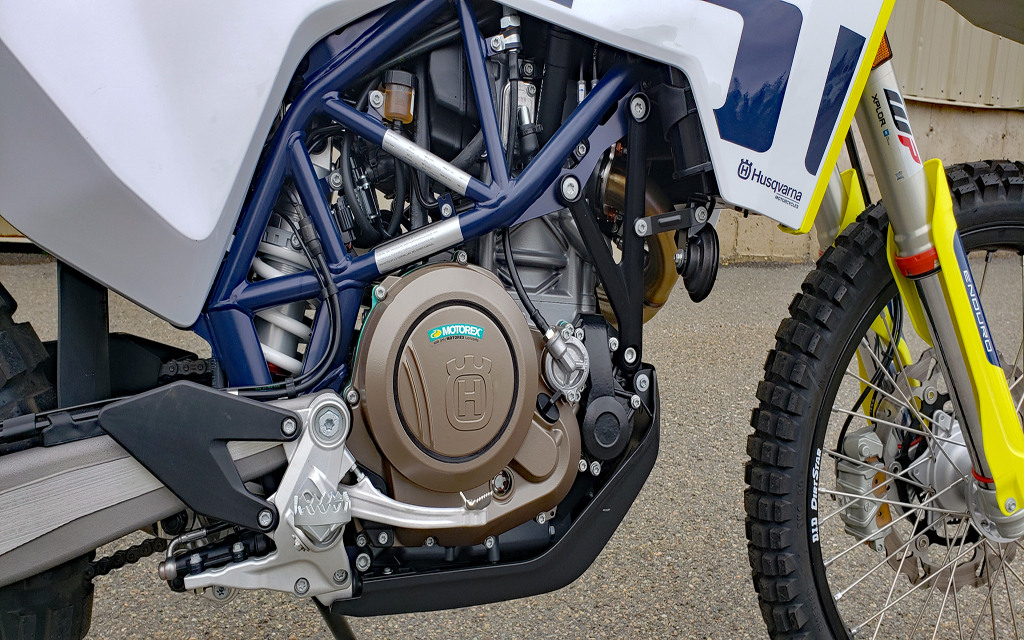
Whether you’re on easy gravel or tighter, rockier trails, the engine will lug along nicely, if you choose to ride the 701 that way for self-preservation. However, if you get all herky-jerky with the throttle, you might turn the bike into the two-wheeled equivalent of an ejection seat. Whisky throttle is never fun, but especially not on a powerful dirt bike.
Stay calm and the 701 is fairly relaxed to ride, though. I never found any rough spots in the fuel injection. The six-speed gearbox gave me no issues, and the power-assist slipper clutch is smooth as silk. The leaning-sensitive traction control rarely engages on-pavement, but it’s a nice bonus feature to have, same as the selectable riding modes. It’s not your classic bone-rattling 650 single—it can actually be a relaxing, pleasant bike to ride, if you want. But where’s the fun in that?
So, the 701’s engine has lots of power. What about the rest of the bike—is it well-matched to the muscled-up single?
The 701 Enduro lives up to its name here, as the chassis is basically an overgrown dirt bike. Is this a good thing, or a bad thing? The answer depends on your perspective.
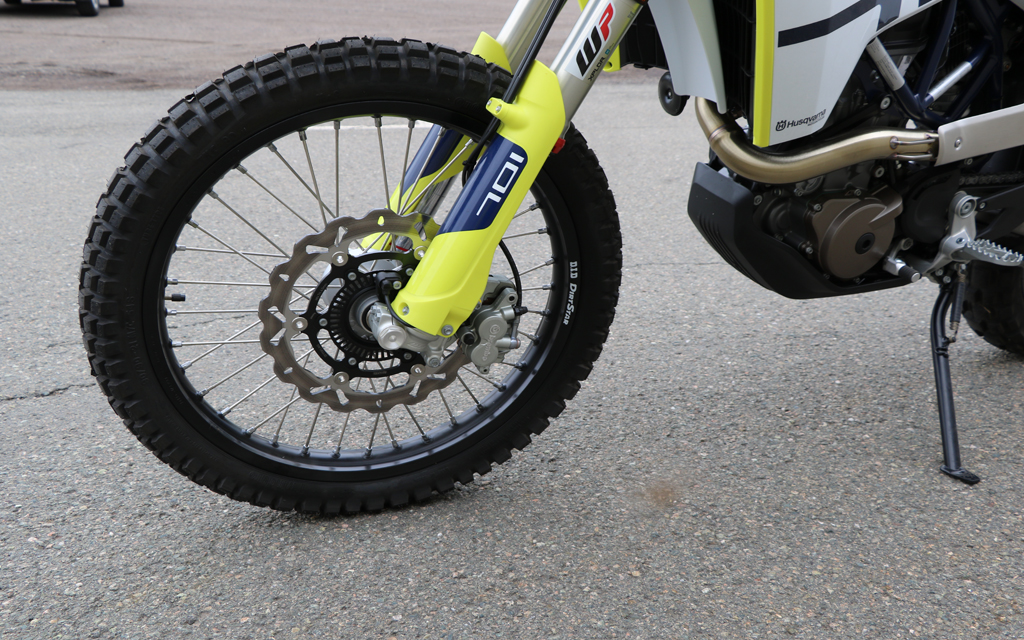
Enduro bikes have tall seats, lots of ground clearance and stiff long-travel suspension. The 701’s seat is a sky-high 920 mm, meaning short-legged riders like myself can find mounting and dismounting tricky at times. If you need to stick a leg out to get through a tough spot on the trail, best to do so carefully, lest you come to grief.
I’d prefer a slightly lower seat, and I’d prefer it to be more comfortable, too, for longer street rides. But, if you want to actually ride this as an enduro, you need a seat that’s easy to move around on, and you need ground clearance. Too bad if it’s on the tall side—learn to ride it anyway, or go buy something a little less extreme. Or, pay someone to lower the seat for you—people do it all the time.
One other note on that seat: because the 701 has groovy space-age styling and a rear-mount gas tank, the seat basically runs all the way forward to the headstock. This means riders can scoot their weight wayyyyyyy forward, with no pesky fuel tank in the way. If you’re used to riding dual sports aggressively, you’ll know that this is a welcome design feature—you can really load that front end down if you want to.
The suspension comes from KTM’s in-house experts, with WP XPLOR forks and shock. The forks have a spring in each side, but the left side only handles compression damping, while the right side handles rebound damping. This separate-function design is very common these days, and it means it’s easier to tune the forks where you want ’em: Left clicker for compression, right clicker for rebound.
I don’t usually mess around with suspension adjustments too much, but I found the 701’s front end was a bit too bouncy for my liking, when riding offroad—maybe I wasn’t riding fast enough, and a bit more speed would have smoothed things out? Whatever the case, I found dialing the rebound back a couple of clicks made everything a lot more pleasant. Adjustment couldn’t be easier.
What about the linkage-type shock? I didn’t mess with it. It did the job, but if I wanted to change things, there are adjustments for compression and rebound. Perhaps if I’d been jumping the 701, or pushing it harder, I would have wanted to tweak things here.
The 701 uses a chrome-moly steel trellis frame, but the subframe is made of roto-moulded polyamide, with the 13-litre fuel tank integrated. This reduces weight, and allowed engineers to centralize the bike’s mass forward. It might mean it’s easier to break (I didn’t crash it to test this theory), but I presume it’s much less expensive to replace if that happens.
Husqvarna put proper aluminum D.I.D. rims on the 701, a 21-inch front and 18-inch rear. That means there’s plenty of choices for tires.
Brakes are standard dual-sport issue, a single disc front and rear. Some riders might want more, with 70+ horsepower on tap, but the lightweight machine doesn’t need any more. The 300 mm front disc (two-piston floating caliper) and 240 mm rear disc (single-piston caliper) will haul you to a stop just fine, and there’s switchable Bosch ABS, too. Disengaging the ABS isn’t as easy as on a KTM adventure bike, but at least you can switch it off, or put the bike into Supermoto mode, which allows you to slide the rear wheel around while slipping the front brake.
Along with that Bosch ABS system (lean angle-sensitive) and traction control (also lean angle-sensitive) the 701 has a ride-by-wire throttle, which in turn allows selectable engine maps. On previous 701 models, you had to fiddle around under the seat to change between maps. Now, there’s a convenient handlebar switch, allowing you to select either Mode 1 (sporty, street-oriented, with more traction control/wheelie control interference) or Mode 2 (enduro-focused, less traction control/wheelie control interference).
I left the bike in Mode 2, and suspect most riders would be happiest this way.
As for other electro-bits, the 701 has all-around LED lighting. I wasn’t impressed with the headlight, but if I was riding the bike at night, I’d come up with a solution. And, there’s an LCD dash. This is very much in keeping with the bike’s enduro theme, providing basic info like tripmeters and rpm, but honestly, the LCD feels a bit cheap, especially considering the 701’s price tag. It gets the job done, though!
The Husqvarna 701 Enduro is ideal for someone with a lot of money, and a lot of riding talent. It’s super-fun on the street, but a less-experienced rider might find it a handful offroad. As for the price tag, with a $13,399 MSRP plus $550 freight, it’s as much as a full-featured ADV bike, or more. KTM’s own 890 Adventure sells for $14,099 plus $550 freight.
But, if you want the brappiest street-legal dirt bike you can buy, the 701 is the ticket. All killer, no filler. It looks good, and it’s ridiculously fun. Many of us have spent more money in worse ways.
